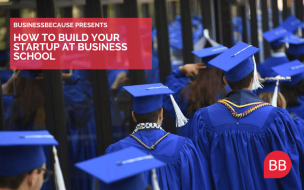Away from the graduation ceremony at ESADE Business School, held in Barcelona, he has been at the centre of disruptive innovation.
Steve, the serial Silicon Valley entrepreneur and father of the lean start-up movement, had come to inspire the about-to-be business school graduates – although for five minutes he was fixated on the audiences’ mobiles.
It had started with the students pulling smartphones out of their pockets and holding them up in front of Steve’s glinting eyes.
“Take a look around,” he asked, waving aloft his black iPhone 5S. “Do you see any BlackBerry’s? There’s always one or two dinosaurs.”
He laughed, scanning the youngsters in his view. “Raise your hand if anyone rented a VHS tape last night – or used a paper map to find yourself here?”
There was a serious point amidst the comedy. “These questions lie at the heart of what I’d like to talk about: the changing face of innovation,” Steve smiled.
His area of expertise has been entrepreneurship. About 26% of all prospective b-school students are considering entrepreneurial careers upon graduation, up from 20 per cent in 2009, according to GMAC.
That is a huge increase on 2013’s prospective students – only 4% of whom are now entrepreneurs. Last year a tranche of ESADE MBAs went on to launch their own businesses. Entrepreneurship has become a defining focus of the school.
The apparent never-ending march towards innovation has been buoyed by the school’s Entrepreneurship Institute (EEI). Since 1997, it has provided a link to all things related to social entrepreneurship and innovation – a relenting focus on which has not dimmed ESADE’s corporate prospects.
More than 90% of their MBA class was employed within three months of graduating last year.
Alessia Diamandidis, a recruitment director at L'Oréal, confirms the view from the outside: “We consider entrepreneurial qualities to be the most important aspect we look for in candidates… globally, ESADE MBA students are much more connected with companies and with innovation and entrepreneurship – qualities that companies are looking for across the board.”
She is not the only one to notice. Droves of corporate giants took part in ESADE events last year, networking with faculty and students alike.
At ESADE’s 2014 graduation ceremony, the focus was clear. Speeches turned to the unprecedented boom in innovation, fuelled by both start-ups and corporate entrepreneurs. About one in 10 business school alumni are thought to be running their own businesses – spanning back a few decades.
Surveys serve as the barometer of confidence in the entrepreneur’s career path. For months last year business schools talked up their efforts. Professors ramped-up their entrepreneurial offering. Incubators took on more MBAs. Last month Steve, who has co-founded or been a part of eight Silicon Valley start-ups, delivered a timely boost to MBA’s hopes.
ESADE’s setting is a measure of how far they have gone down the entrepreneurship and innovation route. The ESADE Creapolis – a creativity park – houses innovative start-ups.
With a €70 million investment, the 46,000 square meter site offers top-quality facilities with the aim of accelerating innovation.
The EGarage, a new space, has created an environment for students to start new business ideas. The EGarage aims to be a launch-pad for students’ ventures.
The influx of entrepreneurial centers across Europe has created a ripple effect, pushing the career path onto the MBA agenda.
But as Steve notes, innovation has manifested itself in the corporate world as much as it has in the start-up community.
“We all witness creative destruction and innovation at work,” says the entrepreneur. “Brands are losing their power, physical channels are being destroyed by virtual ones. Market share is less important than market creation and software is eating the world.
“The convergence of digital trends with the rise of China and globalization has upended the rules for almost every business in every corner of the globe. It’s not a place that you can hide [in].”
Amid his keynote speech, graduates shuffled in excitement. His words did not fall on deaf ears.
As the venture capital business has picked up steam in Europe, start-ups are now awash with capital. Last year, the European Investment Fund committed €1.5 billion into more than 60 VC funds.
As a consequence, existing companies face a tilde-wave of competitors – vastly more than was the case 25 years ago. Steve’s mobile stunt was a subtle comment on innovation in the mobile market.
Nokia has been battered by Apple, a company which is now the most profitable smartphone maker in the world. In Spain, the android operating system commands a 90% market share. Yet world-wide, Nokia’s market share today is less than 5%.
Steve believes innovation will shape today’s graduates’ careers. He has been one of the most successful entrepreneurs in the Valley to date. He has founded two semiconductor companies, Zilog and MIPS Computers, a workstation company, Convergent Technologies, as well as his last business, E.piphany – which was borne out of his living room.
After retiring in 1999 he began teaching entrepreneurship at leading U.S universities. The book he wrote, Four Steps to the Epiphany, launched what was billed as the lean start-up movement.
It is little wonder that Forbes considers him one of the 30 most influential figures in tech – and why his article, Why the Lean Startup Changes Everything, was the cover story of the Harvard Business Review in May last year.
Over the next decade, he predicts that we’ll see two very different types of public companies – one valued on their ability to executive current business models, and one which has the ability to continually innovate and re-invent itself.
“These companies – the ones that can show start-up-like growth rates of 50 plus per cent per year – will get stratospheric valuations,” shouts Steve. MBAs may well point to Tesla Motors or Twitter.
“The question for all of you is: what will it take to inspire and manage this kind of innovation in existing companies?” he asks the audience, his head peering above a giant ESADE logo.
The type of innovation Steve is interested in is the disruptive kind; innovation we associate with start-ups. But big corporations advertise innovational opportunities too.
“Building innovation internally is really hard,” he says – but “companies can adopt the practices of start-ups and accelerators”.
Many firms have established a new type of position, he notes – the chief innovation officer. That executive will run the company’s entire innovation portfolio.
If MBAs want to be a part of this corporate innovation, they may be in luck. Entrepreneurship is not reserved for start-ups.
“Companies world-wide need your help… in making new metrics to manage disruptive innovation,” Steve enthuses.
“And most importantly, they need your help as leaders, who can run companies that both execute and innovate.”
He smiles before leaving the stage, and drops another note of advice. “A pessimist sees danger in every opportunity, but an optimist sees opportunity in every danger. Be an optimist, embrace change and lead the way.”
RECAPTHA :
ec
7a
b9
d7








